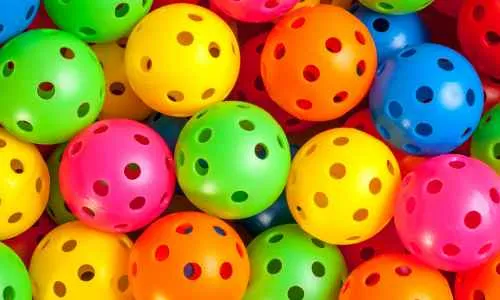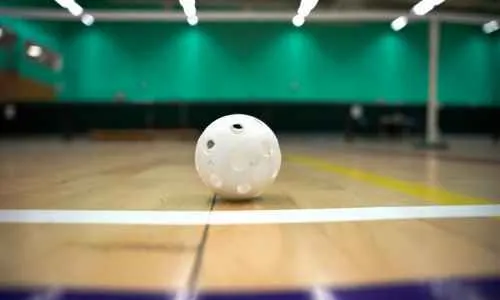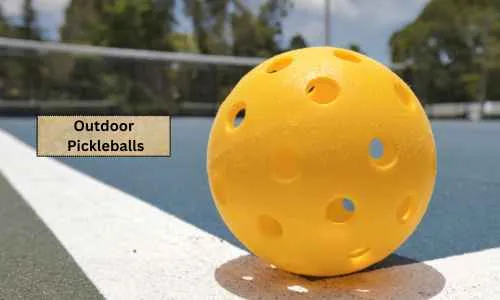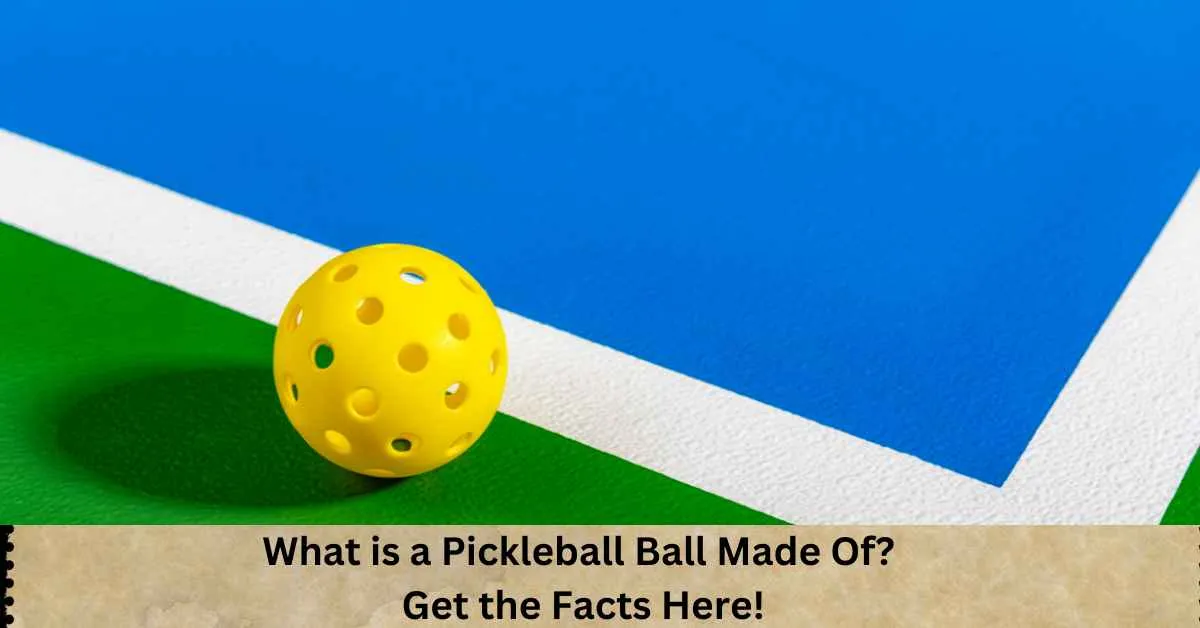Pickleball made of durable materials for smooth play. Pickleballs are made primarily from a combination of polymer, plastic materials, and resin. Explore different types of pickleball balls for your game. Discover a pickleball ball’s composition and explore its fascinating materials. Get insights into the construction and characteristics of this essential equipment for the game.
Table of Contents
What are pickleballs made of:
Pickleball has become more popular in recent years. Are you eager to step into the pickleball world? The rapidly growing sport is recognized for its unique paddle and fast-paced gameplay. But have you ever wondered, “What are pickleballs made of?” Today, we will explore one pivotal aspect of this exciting game – the pickleball ball! Join us as we unravel the mystery behind its composition and discover why it is crucial to your success on the court. Get ready to be captivated by the exciting secrets hidden within each bounce of a pickleball, whether you’re a newbie or a seasoned player.
- The Small-Town Kid Who Became a Pickleball Superstar! Dylan Frazier’s Inspiring Story
- Amazon Prime Day Pickleball Deals 2024: Take up to 50% Off on Paddles
- Pickleball’s ‘low-impact’ reputation doesn’t mean low-injury. How to stay safe playing the fast-growing sport.
- Club tennis ‘endangered’ as other racket sports grow, Novak Djokovic warns
- Pickleball points: Here are some tips and strategies specifically for seniors
specifications of a pickleball ball
The International Pickleball Federation (IFP) maintains a list of approved pickleballs. This list includes pickleballs tested and certified to meet the IFP’s specifications. The specifications of a standard pickleball ball, according to official rules, are as follows:
| Specification | Range |
| Diameter | 2.874 inches (7.30cm) to 2.972 inches (7.55cm) |
| Circumference | 9.03 inches (22.93cm) to 9.34 inches (23.72cm) |
| Weight | 0.78 ounces (22.1 grams) to 0.935 ounces (26.5 grams) |
| Bounce | 30 inches (76.2cm) to 34 inches (86.4cm) when dropped from a height of 78 inches (198.1cm) onto a granite surface plate. |
| Holes | Must have between 26 and 40 holes. |
| Color | Must be Single color. |
When choosing a pickleball, it is essential to consider the type of court surface you will be playing on and your playing style. Indoor pickleballs are typically made of softer materials than outdoor pickleballs, as the indoor court surfaces are not as hard.
What is Material Pickleballs Made Of
Pickleballs are made primarily from a combination of polymer, plastic materials, and resin.
Hard plastic: Hard plastic is the most frequently used to make pickleballs Because it is long-lasting and has a reliable bounce.
Resin: Resin pickleballs are typically softer and more flexible than hard plastic pickleballs. This makes them easier to control but may not last as long as hard plastic pickleballs. Some popular resins used for pickleballs include polyurethane (PU) and thermoplastic elastomer (TPE).
Polymer: Polymer pickleballs are a relatively new type made from various synthetic materials. Polymer pickleballs are typically designed to be durable and lightweight, with a consistent bounce. Polypropylene (PP), polyethylene (PE), and polycarbonate (PC) are typical examples of rigid polymers typically employed in the manufacturing of pickleball balls.

Key Points About Pickleball Materials
Pickleballs are crafted using various materials to meet specific standards and performance criteria. Here are some key points about the materials used to make pickleball:
1. Durable and Smooth Surfaces: The USA Pickleball Association (USAPA) mandates that pickleballs be constructed from durable materials with smooth surfaces. These materials can include resins, rubber, plastic, or combinations thereof.
2. Restrictions on Texture and Hole Shape: Manufacturers are prohibited from adding texture to the ball’s surface. The number and shape of holes are also subject to restrictions to ensure consistent gameplay.
3. Specific Technical Requirements: The ball must be made of smooth molded material with a uniform color. It should have between twenty-six and forty circular, evenly spaced holes. When dropped from a height of seventy-eight inches, the ball must bounce between thirty and thirty-four inches high.
4. Hardness and Material Variance: The hardness of the plastic used is crucial, as the ball must maintain its round shape and bounce consistently. According to official rules, the allowable variance in roundness typically does not exceed around 0.02 inches.
The ball’s hardness should fall within a range of forty to fifty on the Durometer Shore D Scale, which measures the hardness of plastics and rubbers. While plastic is commonly used, other materials like hard rubber may also be employed if they meet weight, bounce, diameter, and other technical specifications.
Manufacturing Process of pickleball
Creating pickleball balls involves a precise manufacturing process to guarantee quality and consistency. Here’s an overview of how these balls are made:
Material Selection
High-quality polymer is chosen for the outer shell, and cork or polypropylene is selected for the core.
Molding
The polymer material is molded into two halves that will later be fused.
Core Placement
The cork or polypropylene core is placed inside one of the molded halves.
Fusing
The two halves are fused, creating a seamless outer shell with a securely enclosed core.
Hole Drilling
Holes are drilled into the ball following a specific pattern, ensuring consistent performance.
Quality Control
Each pickleball ball undergoes rigorous quality control checks to meet the required weight, bounce, and roundness standards.
Variations of Pickleball Balls
Pickleball balls come in two main categories: indoor and outdoor.
Indoor pickleballs are characterized by their softer construction and larger holes than outdoor pickleballs. These attributes result in slower ball speeds and increased control, making them well-suited for indoor play on wood, gym floors, and concrete surfaces.
Outdoor pickleballs, on the other hand, are designed to be harder with smaller holes. This design makes them faster and more durable, making them the preferred choice for outdoor matches on tennis courts, asphalt, and concrete surfaces.
Apart from these main types, specialized pickleball balls are tailored for specific purposes:
Quiet pickleballs are made from a softer plastic material and have larger holes, which helps to minimize noise while playing. These pickleballs are especially suitable for areas requiring noise reduction, such as residential neighborhoods, proximity to educational institutions, or religious establishments.
Weighted pickleballs exhibit greater mass than standard pickleballs, offering heightened resistance against wind and enhanced stability. This makes them an excellent choice for playing in windy conditions, ensuring better control during your games.
High-visibility pickleballs are designed to be brighter and more visible than regular pickleballs. They are perfect for playing in low-light conditions or sunny days when visibility is compromised.

What an indoor pickleball made of
Indoor pickleball made of a softer plastic than outdoor pickleball. This is because indoor courts are smaller and have less wind, so a softer ball is easier to control. Indoor pickleballs also have larger holes, which helps to reduce drag and make the ball slower.
The most common material used to make indoor pickleballs is Polypropylene (PP). PP is a lightweight and durable plastic resistant to cracking and splitting. Indoor pickleballs are sometimes made of other plastics, such as polyethylene (PE) or ABS.
Indoor pickleballs are typically yellow or white. They are sold in individual cans or packs of 6 or 12 balls.
When choosing an indoor pickleball, selecting a ball approved by the United States Pickleball Association (USAPA) is essential. USAPA approval ensures that the ball meets the official specifications for pickleball play.
How to make an outdoor pickleball?
Outdoor pickleballs are typically crafted from robust and resilient materials like Polypropylene (PP) or ABS, which are hard plastics. These materials ensure that outdoor pickleballs can withstand the elements and rough play.
Polypropylene (PP): This lightweight, durable plastic can endure impacts and abrasions. It is also environmentally friendly and can be recycled.
ABS (acrylonitrile butadiene styrene): Another choice is ABS, a sturdy and lightweight plastic known for its resistance to chemicals and heat. Similar to PP, it is recyclable.
Polyethylene (PE) is a versatile plastic found in numerous products, including pickleballs. While it offers the benefits of being lightweight and durable, it needs to catch up regarding impact resistance compared to PP or ABS.

Some outdoor pickleballs are made from composite materials, combining materials like plastic and carbon fiber. These composites are rigid and more durable.
Foam Pickleballs: A Quieter Pickleball Option
Foam pickleballs offer a quieter alternative in the world of pickleball due to their unique characteristics. These balls are made of durable, soft foam that absorbs some of the paddle’s force, making the play sound more peaceful and less disturbing.
When selecting foam pickleballs, ensure they are approved by the United States Pickleball Association (USAPA) to meet official size, weight, and bounce requirements for legitimate pickleball matches. Following are the advantages and disadvantages of Foam Pickleballs
Advantages of Foam Pickleballs:
Noise Reduction: Foam pickleballs are notably quieter, making them an excellent choice for indoor venues or settings where noise levels must be minimized.
Control: With a lower bounce and lighter weight than traditional pickleballs, foam versions are easier to control. This is particularly advantageous for beginners and those still mastering the game.
Reduced Injury Risk: Their softness and forgiving nature lessen the causing injuries, making them suitable for players with joint sensitivities or those prone to injuries.
Disadvantages of Foam Pickleballs:
Durability: Foam pickleballs tend to be less durable than their traditional counterparts and may wear out more quickly, necessitating frequent replacement.
Speed: Foam pickleballs are slower than traditional ones, which may not be suitable for players seeking a competitive or faster-paced game.
Different Feel: The feel of playing with foam pickleballs is distinct from traditional ones, requiring an adjustment period for players accustomed to the latter.
USAPA Approved-Pickleball Balls
USA Pickleball tests pickleball balls to verify they satisfy its standards before approving them. These specs include weight, diameter, bounce height, and flight characteristics.
Consider your court type while choosing a pickleball ball. Indoor pickleball balls bounce lower than outdoor ones.
Outdoor pickleball balls bounce higher than indoor ones. If the ball is not built for outdoor play, it may bounce excessively low on outdoor courts due to its softer surface. USA Pickleball approves the following pickleball balls:
Indoor Pickleballs:
| Brand/Model | Bounce Characteristics |
| Onix Pure Indoor Pickleball | Lower bounce for indoor play |
| Baden G4 Indoor Pickleball | Lower bounce for indoor play |
| Franklin X-40 Indoor Pickleball | Lower bounce for indoor play |
| DULCE DOM Indoor Pickleball | Lower bounce for indoor play |
| A11N SPORTS Elite Pro Indoor Pickleball | Lower bounce for indoor play |
Outdoor Pickleballs:
| Brand/Model | Bounce Characteristics |
| Onix Fuse Outdoor Pickleball | Higher bounce for outdoor play |
| Onix Pure Outdoor Pickleball | Higher bounce for outdoor play |
| Franklin X-40 Outdoor Pickleball | Higher bounce for outdoor play |
| PicklePro Outdoor Pickleball | Higher bounce for outdoor play |
| Fansport Outdoor Pickleball | Higher bounce for outdoor play |
Read More: How Long Does A Pickleball Ball Last? Tips To Extend Its Lifespan
How long will a pickleball last?
The durability of a pickleball can fluctuate due to several variables, playing frequency and environmental conditions. Generally, pickleball may endure anywhere from a few matches to several months.
Indoor pickleballs are softer and possess larger perforations than outdoor pickleballs. Because of this characteristic, they are less durable and more vulnerable to wear and tear.
Outdoor pickleballs are constructed from a hard plastic material with smaller holes, enhancing their longevity and making them more suitable for open-air play.
The regularity of pickleball use is another determinant of its lifespan. Pickleballs engaged in frequent play will naturally experience faster deterioration than those utilized less frequently.
Does the color of a pickleball matter?
The color of a pickleball doesn’t impact its performance but can significantly affect its visibility, particularly in specific conditions.
Brightly colored pickleballs like yellow, green, and orange are more visible than lighter shades such as white and pink. This becomes particularly evident in indoor settings and on overcast days.
If you’re enjoying a game of pickleball in a well-lit outdoor environment, the color of the ball you use might not pose any issues.
Read More: Exploring the top Pickleball Ball colors
Is there a standard size for pickleball balls?
Yes, pickleball balls do have to adhere to specific size regulations. According to official pickleball rules, the diameter of a pickleball must be 2.874 to 2.972 inches (7.30 to 7.55 cm), Circumference is 9.03 to 9.34 inches (22.93 to 23.72 cm), which is a standard size designed to ensure uniformity and fairness in the game. Players must use pickleballs that meet this size requirement for official matches and tournaments.
What is the weight of pickleball balls?
A standard pickleball weighs 0.78 to 0.935 ounces (22 to 26.5 grams). This weight range is specified in official pickleball regulations to ensure consistency in the game.
Pickleballs within this weight range are used for official matches and tournaments to maintain fairness and uniformity in play.
Do kids play pickleball with the same pickleballs as seasoned?
Yes, children typically use the same standard-sized pickleball balls as seasoned. The size and weight of the pickleball, as specified in official pickleball regulations, remain consistent for players of all ages.
What is the speed of pickleball balls?
Pickleball balls typically travel between 25 and 45 miles per hour. However, professional players can hit the ball much faster, with some players able to smash the ball at speeds of up to 60 miles per hour.
Can you recycle pickleball balls?
Most pickleball balls are crafted from LDPE (low-density polyethylene), a type of plastic that falls under recycling category #4. Typically, you can identify LDPE by the recycling symbol with 4 imprinted on the ball’s surface.
However, it’s important to note that not all pickleball balls are equally recyclable. Certain pickleballs are crafted from composite materials that incorporate a variety of plastics, contributing to recycling efforts.
Conclusion
In conclusion, the composition of a pickleball is more intricate than one might imagine. The core, surface, and color are all carefully considered to enhance the gameplay experience. Whether you’re a novice looking for a gentle bounce or a seasoned player seeking power and spin, pickleball is designed to meet your needs. But remember, regardless of the pickleball’s material, what truly matters is the enjoyment that this sport brings. So, grab your paddle, head to the court, and let the game of pickleball unfold.

